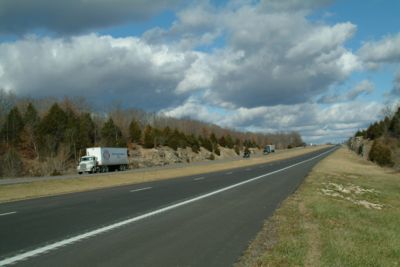231.2 Clear Zones
Contents
231.2.1 Introduction
The clear zone concept is the road design principle of providing an unobstructed, traversable area beyond the edge of the through traveled way for the recovery of errant vehicles. The concept was developed in the 1960s and later incorporated into the Roadside Design Guide (RDG). The RDG suggests clear zone distances based on traffic volumes and speeds. These distances are neither absolute nor precise and, in some cases, it may be reasonable to leave a fixed object or non-traversable terrain within the clear zone area. Roadside design strategies involve the following:
- 1. Remove the obstacle
- 2. Redesign the obstacle for safe traversal
- 3. Relocate the obstacle further from the roadway
- 4. Reduce obstacle severity (make it breakaway)
- 5. Shield the obstacle
- 6. Delineate the obstacle (when we must leave the obstacle)
The clear zone concept guidelines in the RDG may be most applicable to new construction and reconstruction/rehabilitation projects. Fixed objects and non-traversable terrain features may also be addressed on existing roads as part of resurfacing (1R) or resurfacing and restoration (2R) projects (see EPG 128.2 Preventive Maintenance Projects (1R and 2R)). Every roadside should be made as safe as practical. On existing roads, primarily those of an older or lower-order nature, a clear area may be established through maintenance activities. While this practice is strongly encouraged, these areas should not be construed as providing the same safety benefit as clear zones.
Clear zones are reviewed and/or selected based on the RDG guidelines after consulting the location study report.
Clear zones are designed into a project when the anticipated posted speed of the roadway is 45 mph or more. When the anticipated posted speed is less than 45 mph, clear zones are still beneficial, but they are to be considered only if economically feasible. Non-traversable slopes or fixed objects are to be removed, redesigned, relocated or shielded by a barrier if they are within the indicated minimum clear zone width and it is cost effective to do so.
The clear zone width is to be applied with good judgment and should be balanced with project costs. Limited right of way or high construction costs may lead to the installation of a barrier or possibly no protection at all.
231.2.2 Clear Zone Perception Issues
In most cases, the use of the clear zone concept is preferable to the use of a shielding barrier. There is, however, a notable exception.
Occasionally the public will poorly perceive the clear zone concept. In areas of very high fills, particularly those on the outside of a horizontal curve, the clear zone alone may give the impression of an unsafe situation. Even though the design may be completely safe within the guidance of the RDG the public will inevitably request the area be shielded, most often with guardrail.
In these cases, the best practice is to initially specify shielding. By doing so, MoDOT can avoid the needless expense of eventually using both treatments in the same location.
231.2.3 For Bridges and Culverts
Clear zones, when used, shall extend full-width to bridge ends. Where the existing roadway is to be incorporated into the completed facility as part of the main roadway, the use of clear zones will be considered on individual projects.
The use of clear zone typical sections is not applicable to small culvert replacement projects where the intent is to continue the service of the road without upgrading it. In such cases, the typical sections used in the original construction are to be used except that the roadbed width is not to be more narrow than 24 feet.
In shallow fills and in cuts where box or pipe culvert normally require a headwall to be located in the clear zone, the structure should be extended to place the headwall at the outside of the clear zone or a safety appurtenance (guardrail or barrier) should be provided. The slope of the clear zone will then require modification over the entire surface.
231.2.4 On Ramps
Flattened slopes or clear zones are to be used on ramps to eliminate the use of guardrail. Use guardrail only to protect bridge ends within the interchange area.
231.2.5 In Unusual Conditions
When a standard clear zone width and slope will not properly terminate on the existing ground surface because of hilly conditions, steeper slopes must be used. In this case, the clear zone may be omitted and guardrail used at the shoulder line. The desirable minimum length for the elimination of clear zone is 500 ft. but in no case less than 250 feet.
For long fill sections through a reservoir project, clear zones can be eliminated and guardrail used at the shoulder lines.
Speed change lanes adjacent to main roadway are to be placed within main roadway's clear zone with no widening of clear zone. The clear zone is always located adjacent to and measured from the normal edge of the pavement of the main roadway including climbing or continuous auxiliary lanes.
231.2.6 Maintenance
District personnel shall be responsible for maintaining clear zones on highways.
